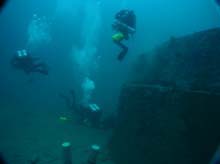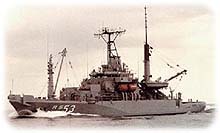
NOAA research divers explore the Monitor's turret. These free-swimming divers have good mobility and can hover or swim over the wreck. (Monitor Collection, NOAA) Click image for larger view.
The Mission Plan
John Broadwater, Manager
Monitor National Marine Sanctuary
Phase 1 Objectives
As we prepare for Phase I of a three-phase NOAA/U.S. Navy expedition to the Monitor National Marine Sanctuary, it is daunting to contemplate the months ahead. Counting the three-week NOAA survey expedition just completed, we will visit the Monitor five times this summer, between April and September. NOAA's Phase I consisted of survey dives from March 25 to April 13. The Navy's Phase I consists of preparatory site work by the USS Grapple from April 19 to May 11. (Read more about the phases) We will recover the Monitor’s 30-ton steam engine, a segment of the armor belt and a variety of artifacts. We will begin the arduous task of preparing the famous gun turret for recovery next year. We will be at sea for more than 14 weeks, not counting seven weeks of daily trips to the site on two NOAA expeditions. This is, by far, the most complex operation ever conducted at the sanctuary. As the Sanctuary Manager and NOAA’s chief scientist for the expedition, I am excited, but, at the same time, apprehensive, because the Monitor is in "delicate" condition and could collapse at any time.
Phase I Preparations
Photographic evidence clearly shows a marked increase in the rate of deterioration of the Monitor’s hull since 1990, apparently the result of both natural and human causes. During the 1998 mission to the Monitor, U.S. Navy and NOAA divers mapped and documented key areas of the vessel's hull, mapped and recovered exposed artifacts, and recovered the unique cast-iron propeller and a section of shaft. In 1999, NOAA and Navy divers documented and mapped areas of the hull slated for stabilization and recovery activities.
In 2000, Navy divers shored up the Monitor's hull with cement bags, mapped the engine, and recovered the skeg (a support for the rudder and propeller) and the remaining section of propeller shaft. The Navy also deployed a 90-ton engine recovery structure, all in preparation for this year’s engine recovery expedition. Now the time has come, and none too soon--we have already documented significant deterioration since just last year. Although we partially stabilized the hull last year, a partial collapse of the stern is still possible.

Divers from the Navy salvage ship, USS Grapple will install a hydraulic lifting system to the engine recovery structure. Click image for larger view.
Phase 1 Begins
On April 21, we departed from the Naval Amphibious Base at Little Creek, Virginia, aboard the USS Grapple, a Navy salvage ship. The Grapple’s divers will install a hydraulic lifting system to the engine recovery structure and position an engine lifting frame just above the Monitor’s engine room. Time permitting, they will conduct an engine survey, install additional shoring material beneath the hull, and recover artifacts that could be damaged during the recovery operations to follow.
The work is slow and difficult. The unpredictable and often violent seas at the site, the strong currents, and the constant threat of storms and hurricanes make underwater tasks painstaking. Because of the Monitor’s depth (235 feet), Navy divers can only remain on the wreck for approximately 30 min, after which they must spend nearly three hours decompressing (slowly returning to surface pressure) to avoid the painful condition known as "the bends."

Mosaic showing the Monitor from the stern. The displaced turret supports the armor belt along the port side of the wreck. The white frames in the image are cradles for 200-pound sacrifical anodes used to retard corrosion. (Monitor Collection, NOAA) Click image for larger view.
Phase II
The real test of our planning and preparations will come during Phase II. Nearly four weeks of mobilization will precede a 45-day expedition beginning with the arrival of a 300-ft-long barge at the wreck site in mid-June.The barge is equipped with a 300-ton derrick crane, accommodations for 100 personnel, and equipment to support two simultaneous dive operations. The barge will be positioned over the wreck, then held in place with eight large anchors, each on a cable that can be adjusted so that divers can be lowered to specific locations on the wreck.
This phase will employ divers from a half-dozen Navy units and will bring the latest technology to bear on the mission. The primary goal is the recovery of the Monitor’s steam engine. Because the wreck lies upside down, Navy divers must rig cables and straps to the engine in order to attach it to a 14-foot-square steel engine lifting frame. The frame, in turn, is suspended from a spreader lying across a 70 ton bridge assembly. Once the engine is securely rigged, it will be slowly lifted to the base of the spreader; then, the entire assembly, weighing approximately 120 tons, will be lifted to the surface and placed on a waiting barge.
The engine, with a section of the lower hull still attached, will be transported to The Mariners’ MuseumDuring Phase II, we also hope to remove a section of the hull and armor belt that now lies atop the turret. This will give us access to the turret so that we can begin the tedious process of excavating the contents of the turret, removing the guns, carriages and other items, and preparing the turret for recovery in 2002.
Phase III
During Phase III, Navy divers on the USS Grasp and NOAA divers aboard the R/V Cape Fear will continue preparatory work for the 2002 expedition. A NOAA dive team will conduct postrecovery survey tasks from July 17 to August 11 (this will overlap the Navy's Phase II). The Navy's Phase III will involve postmission survey and recovery tasks from August and September, including three weeks of demobilization.
The time has come: The Monitor 2001 expedition is under way.
Sign up for the Ocean Explorer E-mail Update List.






















